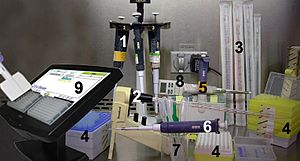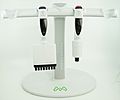Pipette facts for kids
A pipette is a special tool used in science labs to move a very exact amount of liquid from one place to another. Think of it like a super-accurate dropper! Scientists, doctors, and researchers use pipettes all the time to make sure their experiments and tests are done correctly.

1. Adjustable pipettes, from left: 20-200μl, 2-20μl, 100-1000μl
2. Graded transfer pipette and electric pipette filler
3. 25, 10, 5 and 2ml transfer pipettes
4. Disposable tips for adjustable pipettes
5. 12 channel adjustable pipette for microplates
6. Low retention 0.5-10μl adjustable pipette
7. Squeezable transfer pipettes
8. Digital adjustable pipette
9. Light guided pipetting system
Some pipettes are simple plastic tubes with a squeeze bulb, like a basic dropper. These are called teat pipettes or transfer pipettes. You squeeze the bulb to suck up liquid and then release it to let the liquid out. They are good for moving liquids when you don't need super precise measurements.
When you need to measure very tiny amounts of liquid, like fractions of a milliliter, you use a micropipette. These are designed for extreme accuracy.
What is a Pipette Used For?
Pipettes are essential tools in many scientific fields. They help scientists measure and transfer liquids with great precision. This is very important because even a tiny mistake in liquid amounts can change the results of an experiment.
Why Precision Matters in Science
Imagine you are baking a cake. If you add too much or too little of an ingredient, the cake might not turn out right. In science, it's even more critical. When scientists are working with chemicals, medicines, or tiny cells, they need to be extremely accurate. Pipettes help them do this.
Where You Find Pipettes
You will find pipettes in many different places:
- Biology labs: For studying cells, DNA, and tiny organisms.
- Chemistry labs: For mixing chemicals to create new substances or test reactions.
- Medical labs: For testing blood samples, developing vaccines, or preparing medicines.
- Research facilities: For all sorts of scientific discoveries.
Types of Pipettes
There are many different kinds of pipettes, each designed for specific tasks and levels of accuracy.
Simple Transfer Pipettes
These are the most basic pipettes. They are usually made of plastic and have a small bulb at one end. You squeeze the bulb to draw liquid into the tube. They are often used for general transfers where exact measurements are not needed. They are also known as Pasteur pipettes.
Volumetric Pipettes: For Exact Amounts
Volumetric pipettes are glass tubes with a single mark on them. This mark shows a very precise volume, like 10 ml or 25 ml. They are designed to deliver that exact amount of liquid very accurately. They are often used in chemistry for preparing solutions.
Graduated Pipettes: Measuring Different Volumes
Graduated pipettes are also glass tubes, but they have many marks along their length. This allows you to measure different volumes, not just one fixed amount. You can choose to draw up 1 ml, 2 ml, or any volume up to the pipette's maximum capacity.
Micropipettes: For Tiny Drops
Micropipettes are the most accurate type of pipette. They are used to measure and transfer extremely small volumes, usually in microliters (µl). A microliter is one-millionth of a liter, which is incredibly tiny!
How Micropipettes Work
Most micropipettes use a piston-driven air displacement system. This means they use a small air cushion to pick up and release the liquid. They often have adjustable settings, so you can dial in the exact volume you need to transfer.
Why Micropipettes Are Important
Micropipettes are crucial in fields like molecular biology and biochemistry. They allow scientists to work with very small samples, such as DNA, proteins, or tiny amounts of medicine. This precision helps in developing new treatments and understanding complex biological processes.
Images for kids
-
Carlsberg pipettes, glass micropipettes, named for the place for their invention and first use, The Carlsberg Laboratory, Physiology Department, Copenhagen, Denmark. Used with a mouthpiece for precision biochemical and physiological labwork. From the top: double constriction pipettes for 1 and 10 microlitre, single constriction pipettes for 200, 2,000, and 10,000 microlitre
See also
 In Spanish: Pipeta para niños
In Spanish: Pipeta para niños


















